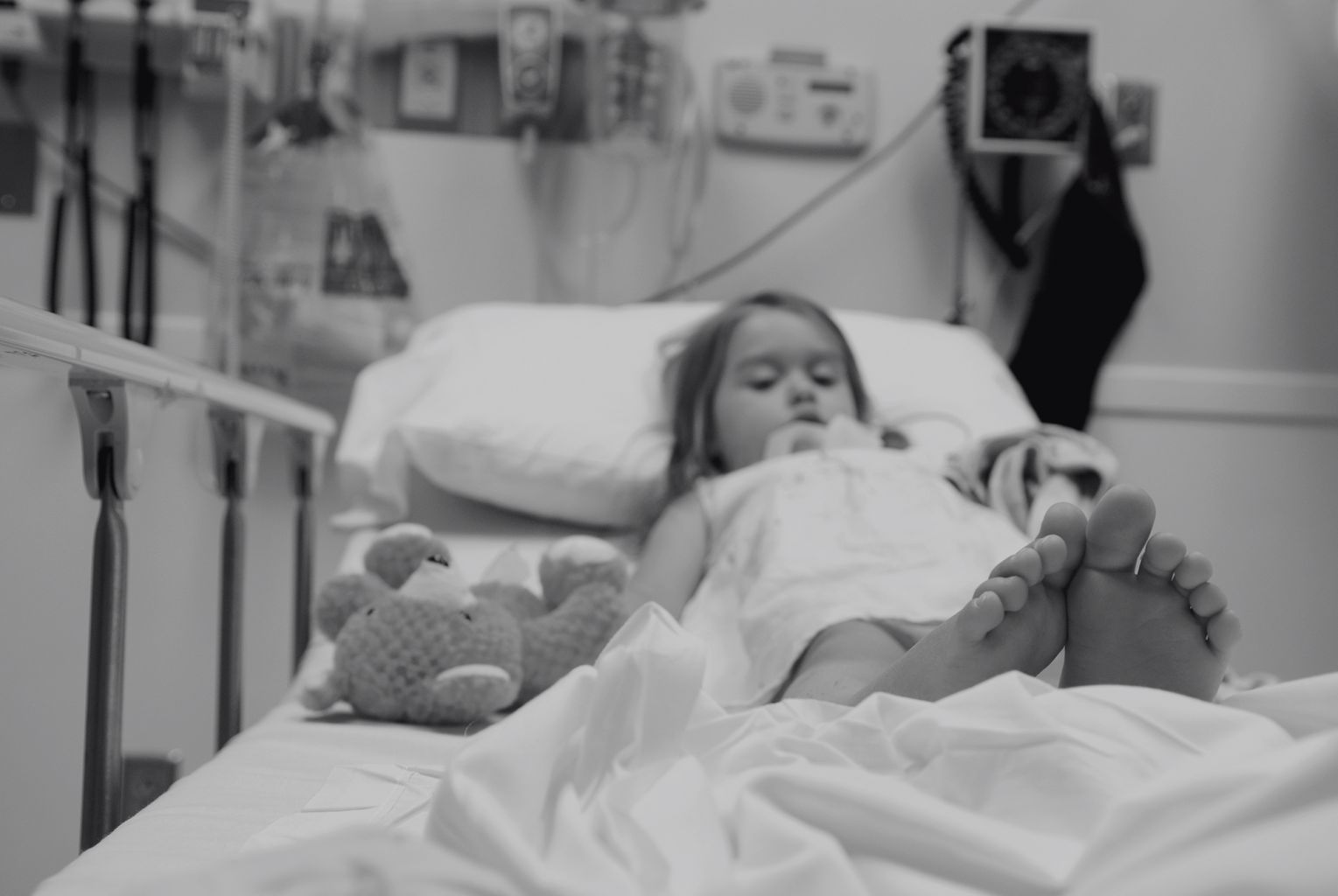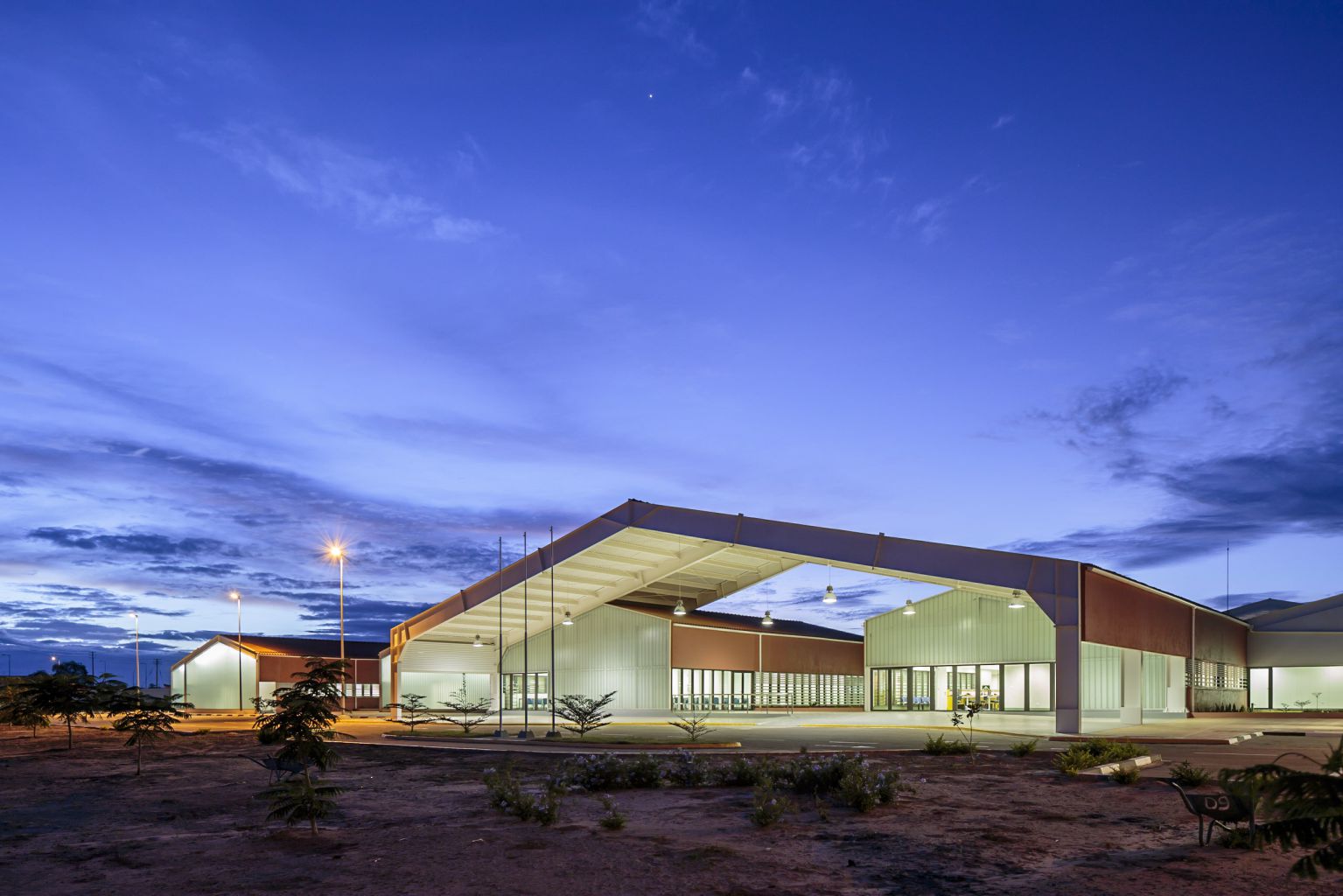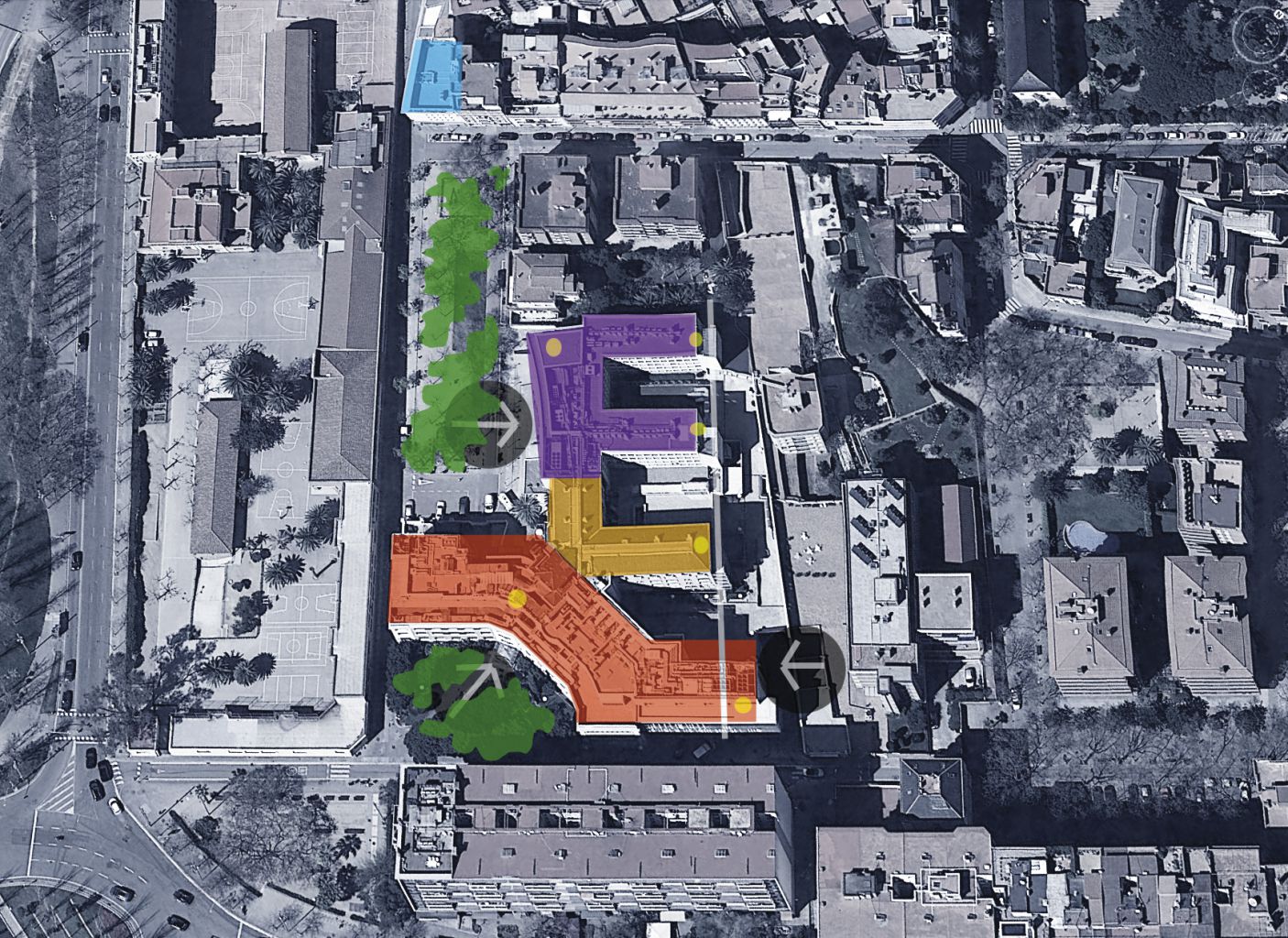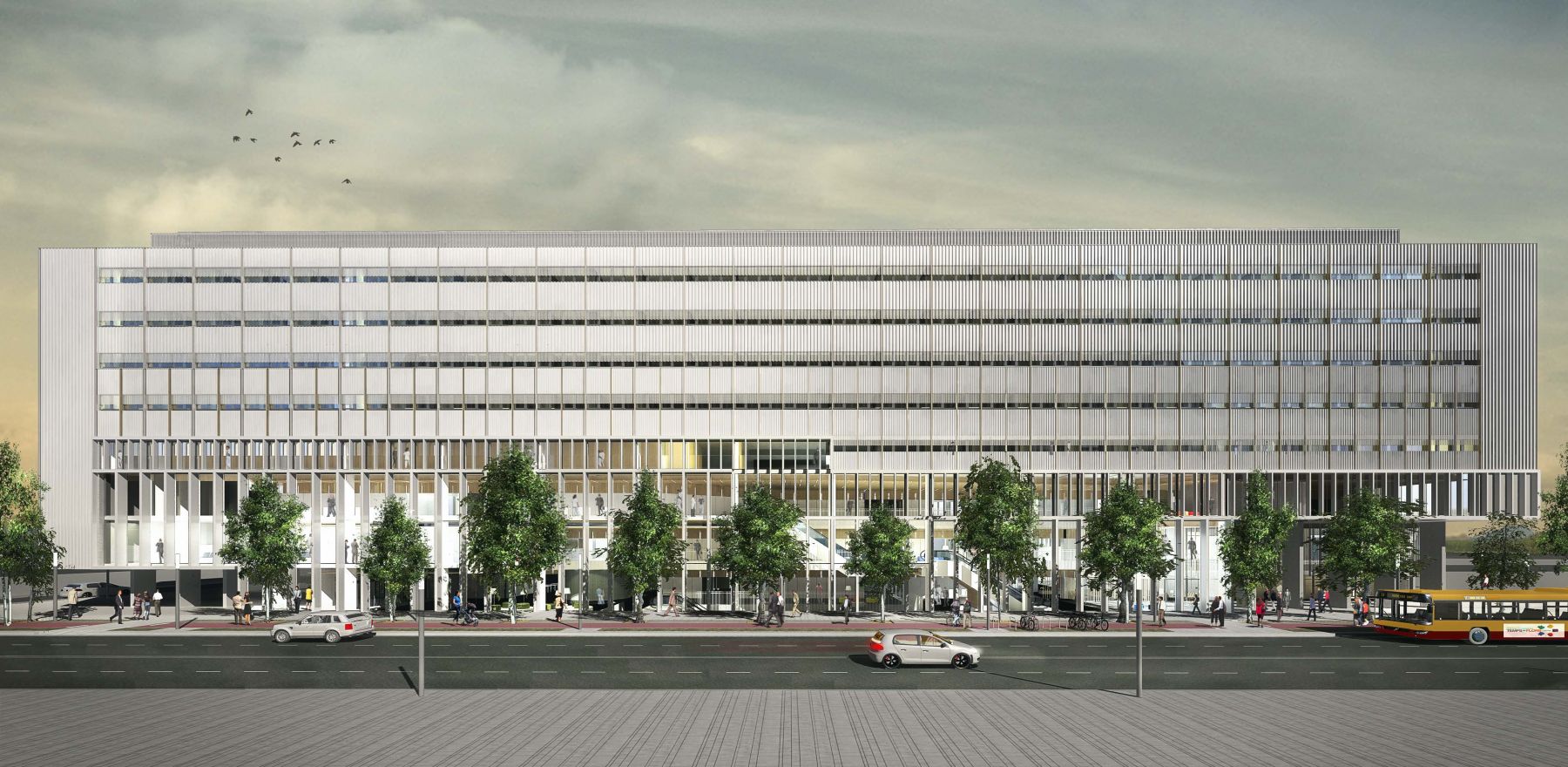A hospital is one of the most complex buildings we can find. Its design is closely related to its smooth operation and, consequently, its safety: a well-designed hospital is, in all probability, safer. Therefore, the main objective of hospital architecture should be to optimise the design in order to make the hospital as safe, efficient and intelligent as possible. Only by keeping these objectives in mind can we make the hospital a space that truly cares about people's health. In the end, as the World Health Organisation (WHO) states in its constitution, the access to the highest attainable standard of health is one of the fundamental rights of every human being.
Just as there are architectural typologies that have evolved due to more artistic and conceptual aspects, the hospital design has undergone typological changes for reasons that are always outside the architectural concept itself. It has been driven by ‘revolutionary’ factors stemming from social or scientific changes. Looking briefly at how hospital architecture has evolved throughout history allows us to understand how it works and what we should expect in the future.
The word ‘hospital’ comes from the Latin word ‘hospes’ meaning host. In Ancient Greece, the concept of the hospital took shape in the temple of Aesculapius, the god of health and medicine, which was a place more dedicated to spiritual healing rather than the body. Over the centuries, we can properly place the first hospitals in monasteries throughout the Middle Ages, which were driven by a social-religious role: under doctrines such as charity or mercy, the church was the only institution that cared for the sick.
Evolution of hospital architecture
The next major typological change came with the transition from the courtyard or cloister hospital of the monasteries and abbeys to the ward system of the mid-19th century. This new system was implemented following the discovery of infectious diseases and the hygienist principles of Florence Nightingale: separating patients into separate spaces was the most effective way of avoiding mass infection. The 19th century also saw the birth of the official medical associations, which in Spain are the Spanish Medical Association (Organización Médica Colegial de España) and the General Council of Official Medical Associations (Consejo General de Colegios Oficiales de Médicos).
With the discovery of antibiotics, infections decreased and forced health care facilities to be managed differently. Hospitals were once again placed in the centre of cities. Massive hospitals emerged and, with the advent of the lift, a new era began: hospitals began to grow in height. But experience showed that this growth was clearly limited by the intrinsic characteristics of the lift - its speed, its technical development, etc. For this reason, the model went from the large monolithic tower to the base model or base plus tower model i.e. the grid hospitals of recent decades.
In recent years, hospitals have evolved only slightly. In the last century, hospitals were machines for healing in very compact buildings with poorly organised circulations, little ventilation and little natural lighting. That's how most hospitals are today: they are about 70 years old and very tall. And while they may work well, they often have problems with size, layout or rooms.
To overcome these problems, hospital architecture must be revolutionised once again. In an evolutionary step forward, performance improves slightly on a previously consolidated base. But a revolution is more than a simple improvement, it is a change in everything that substantially modifies the way of doing things, which is the case of architecture and design. At PMMT we have critically reflected on hospital architecture and where ‘the hospital of the future’ is going, and we have identified a series of characteristic changes in which today's hospitals should undergo; changes which will be regarded as revolutionary. In an environment of maximum flexibility and continuous improvement, the areas that will define these transformations will be the following:
The revolution for hospitals, clinics and health centres
- A firm commitment to Universal Accessibility as opposed to mere accessibility. The hospital must be designed with the latest parameters of  universal accessibility and the highest standards that currently exist for it to be fully inclusive. A hospital that is a paradigm of universal accessibility will be a hospital for everyone: our design must allow all users to access and use the building independently, without any kind of barriers, impediments or dangers.
universal accessibility and the highest standards that currently exist for it to be fully inclusive. A hospital that is a paradigm of universal accessibility will be a hospital for everyone: our design must allow all users to access and use the building independently, without any kind of barriers, impediments or dangers.
In order to be able to apply universal accessibility measures, it is essential to understand the different needs that users have when interacting with architecture. At PMMT after a three-year research project, we have managed to compile allthese needs and fully develop an objective method of analysis and implementation of universal accessibility for any type of building: Clear Code Architecture. This method allows us to know what level of accessibility a space, or group of spaces, currently have and to propose actions that would help improve it to the highest level possible.
- The use of healthy materials and the design of work environments that have a positive effect on people's health, going beyond low-performance materials and work spaces. We need to start thinking of materials not simply as cladding elements that give a hospital or other building an image or look, but materials that can actively contribute to people's health and well being.
Our Friendly Materials methodology allows us to objectively assess the materials that make up built spaces,  enabling us to make a qualitative comparison between different types of products, construction systems and interior spaces. Friendly Materials not only allows us to carry out evaluations, it helps us design healthier buildings based on objective information. Furthermore, even though it was developed in the hospital sector, it is intended for all spaces that are occupied on a permanent basis - such as offices, schools and homes (see MIT Technology Review).
enabling us to make a qualitative comparison between different types of products, construction systems and interior spaces. Friendly Materials not only allows us to carry out evaluations, it helps us design healthier buildings based on objective information. Furthermore, even though it was developed in the hospital sector, it is intended for all spaces that are occupied on a permanent basis - such as offices, schools and homes (see MIT Technology Review).
- Parametric design to guarantee typological hyper-flexibility. In other words, the search for an optimal model that can adapt to any possible case, based on a series of rules, metrics and strategies common to all healthcare facilities to guarantee they run smoothly and correctly, whatever their particular characteristics may be. Furthermore, the parameters must allow the building to be customised from the outset, as well as allowing the adaptation of any future changes.
Our Parametric Hospital is based on the idea of developing a state-of-the-art, fully-featured, customised hospital. This model allows us to build the hospital nearly 3 times faster than a standard hospital without sacrificing any of the characteristics of a conventional project,  that is, with a customised design for each case, and with quality buildings that last over time.
that is, with a customised design for each case, and with quality buildings that last over time.
- The mathematical design is based on scientific evidence which improves the current design, evidence coming from experience and intuition. The design through mathematical analysis is the search for efficiency on different fronts, and means being able to design the infrastructure of a hospital,especially its structures and flow of communication - based on mathematical models that objectively guarantee they are the most efficient systems and flow. It is this data that will ensure the most efficient use of the infrastructure on a day-to-day basis.
- The self-sufficient hospital is able to reduce the demand of energy in order to cover all needs with active and passive strategies as well as renewable energies. Our research project related to hospital self-sufficiency is Energy 0, which proposes entirely efficient solutions for the most extreme scenario: building a hospital on Mars. Working with these extreme scenarios forces us to find the most efficient solutions.
- The smart hospital where big data and artificial intelligence come together to process 50 or 60 years of treatments in every hospital to personalise the most efficient treatments, going beyond the emergence of ICT and current Big Data. We have to re-generate the concept of a revolution of the hospital model to move on to what is already happening in large R&D companies: the incorporation of Artificial Intelligence (AI). By doing so, we will be able to process all the data generated by the hospital infrastructure and draw conclusions from Artificial Intelligence.
- The cyborg hospital is seen as an evolution of the technological hospital, in which new technologies will merge with materials and will be integrated into new generation building systems to interact and boost the efficiency of new working environments, as well as user experience and confidence. This evolution will enable collaborative work of doctors, nurses and biomechanical engineers in hospitals built and designed to house these new technologies.
- The humanised hospital, as the backbone, focuses on the experience of the user and employee. The strict functional requirements will ingrain emotional concepts such as empathy, humanism, a sense of comfort and security, all of which will always come before image focused design and architectural form. Hospital architecture, therefore, refocuses on what is most important: the well-being of people.
The typological model of the hospital as a building must change in line with these revolutions. That is why it is not enough for a contemporary specialist architect to be attentive to the trends and practices of the moment. Even less so when it comes to hospital architecture. The architect must be attentive to information regarding new trends in healthcare, information technology, science, humanities, etc.. These trends indicate the revolutions that will affect healthcare facilities in the immediate future.
We have to rethink how we design the hospitals of the future, how we build the capsules for all these revolutionary transformations, which will in turn accommodate new functionalities and needs based on social, cultural, scientific and technological developments.
Innovation in construction
This is PMMT's commitment, and that is why we allocate 20% of our resources to R+D+i. This commitment has given rise to Clear Code Architecture, Friendly Materials, Parametric Hospital and the Clear Code Handle: a total of 10 research projects that are now an essential part of all architectural projects we design. This is how we are able to integrate research and production, forming a mutually beneficial combination.
We are convinced that the hospitals of the next 50 years will be the perfect blend of technology and soul. The search for this balance between the careful incorporation of the latest technological advances and the creation of humanised environments that serve people and improve their well-being, is what will set the guidelines for the design of these healthcare infrastructures and the new hospital architecture.
Ultimately, healthcare environments have to be humane: this is the only way for them to serve people's health. Humanisation must return to the heart of the hospital architecture debate. Because at some point architecture has lost its way: the focus has shifted from human beings (human comfort) to other aspects, be they aesthetics, economy, efficiency, trends or cultural affirmation. Out of unconsciousness or interest, it has often been forgotten that humanisation is inherent to architecture, it is part of its very definition.
We must not forget that the core function of architecture is to humanise spaces: to convert a hostile environment into a human environment. That means creating conditions so that the place I am in is as comfortable as it can possibly be, as ‘human’ as possible. It is raining, but I am sheltered; it is cold, but my dining room is warm. This is the ultimate role of architecture; because what I need from my environment is not to get wet, nor get cold, but to be comfortable.
An unfocused hospital architecture (or hospital architecture focused on other priorities) has had a direct consequence to the loss of its humanisation. And now we must add an adjective to a noun that has given up its essence. But it is unnecessary to bring up the subject if we are talking authentically about architecture: the challenge, therefore, is to give back to architecture what never should have been lost. The challenge is to re-humanise architecture.
How can architects humanise a room? Simply by making good architecture, by making architecture that focuses on the human being; in our case, on the patient and the doctor. And good architecture is complex, because it must take into consideration the wide range of diversity of the human being, in his or her wide range of preferences and needs. It means attacking the objective from many angles.
Humanisation can only be achieved by thinking about how to improve the quality of life of each user, and by doing so is to understand that there will be a patient with particular circumstances. The true objective, therefore, is to generate comfort and well-being for those using the space. Architecture must have a multi-faceted vision of patient comfort, and intervene from all sides to make a room human: universal accessibility, use of healthy materials, energy efficiency, typological hyper-flexibility, integration of technologies and artificial intelligence, lighting, thermal and acoustic comfort, etc.
These perspectives correspond to the areas that, in our opinion, should be the subject of a revolution in health infrastructures. These are the most obvious facets of this complex polyhedron which is the relation between patient comfort and the length of their stay in a hospital. At PMMT we are researching to achieve a better service with patients in mind, and above all, with each and every patient in mind ; this is the only way we will be able to make the patient the centre of the experience and of hospital architecture. An example of execution under these premises is the new room for patients at Clínica Corachan, which is explained in detail in Hospitecnia, which is an extremely useful architecture, engineering and hospital management portal for design professionals and service providers in the health sector, as it brings together and disseminates knowledge of the hospital sector as a whole.
; this is the only way we will be able to make the patient the centre of the experience and of hospital architecture. An example of execution under these premises is the new room for patients at Clínica Corachan, which is explained in detail in Hospitecnia, which is an extremely useful architecture, engineering and hospital management portal for design professionals and service providers in the health sector, as it brings together and disseminates knowledge of the hospital sector as a whole.
What role does healthcare infrastructure play as a tool for the development of a humanisation strategy? As soon as a patient enters a healthcare facility, he or she becomes aware, even on initial contact, whether or not the patient is greeted with humanity and kindness, and whether or not the facility physically and architecturally meets basic design criteria for the patient’s well-being. Health facilities accompany the healing processes: they facilitate or hinder them. Therefore, architecture and interior design can facilitate, speed up or slow down the patient's recovery. Spaces designed for healing and care exist and can be created, i.e. spaces for interacting with the five senses. Here are some of the elements to consider:
- Conscious and intentional care of the impact of light (respecting the circadian cycle, complementing natural light with artificial light in the right measure).
- Access to natural spaces designed to stimulate the senses by combining different shades of colour, textures, reflections and shadows, and even scents. Fountains or hanging mobiles that sound in the wind.
- Use of images, vinyl, photography, etc. that simulate natural landscapes.
- Use of healthy materials or Friendly Materials: we spend 90% of our time in closed buildings, the polluting elements in buildings are between 2 to 5 times higher than those found outside.
- Spaces that seek visual comfort with calming and soft designs such as round elements and features. Friendly and De-stressing spaces.
- Acoustic comfort, sound-absorbing curtains, etc. to mitigate sound (imagine spending a few days in the ICU).
- Spaces for intimacy and reflection, and spaces to spend time with the family: ‘magical spaces’ that in themselves are facilitators for creating a positive experience or the setting for a good story.
Spaces have to consider the psychological needs of people and recognise the interactive processes that occur between people and the environment. This is known as architectural psychology and neuro-architecture where spaces must consider the need for: admission (welcoming people as a guest); familiarity; respect for privacy; sensory comfort; and ease of orientation (need for control). There is scientific evidence that architecture psychology and neuro-architecture reduces stress levels and anxiety, lowers blood pressure, reduces the need for sedation in children, perception of pain and depression, while also positively affecting the mood and encouraging an early discharge
The debate on ‘humanisation’ is very much alive in healthcare engineering, with many articles available in the Virtual Library of the Spanish Association of Hospital Engineering and, of course, among all those who operate within the health sector. This is why the Institute for the Development and Integration of Healthcare (IDIS) foundation launched a study called “Patient Experience. First Measurement Study in Private Healthcare in Spain" in 2018 which provided data from more than 10,000 people who have experienced at least one of the stages of the patient journey: access to the system, emergency, consultation, diagnostic tests and hospitalisation. 
It is exactly this binomial concept of hospital architecture (soul and technology serving people) that are applied to our projects. At PMMT we offer the knowledge acquired from over 25 years of experience in the design and construction of large hospital infrastructures and highly complex projects. We are a company specialising in advanced healthcare architecture with more than 2,500,000 m2 designed nationally and internationally, with completed projects in Europe, America and Africa.
In the last five years, we have built 7 hospitals in Ecuador, Bolivia, Equatorial Guinea and Angola. In public works, PMMT is currently carrying out the extension of the Trueta Hospital in Girona and the Primary Care Centre (CAP) in Amposta for Infraestructures de la Generalitat de Cataluña. In other parts of the country, we have recently begun work on the new Girona Clinic, as well as extensions of the Vithas Xanit International Hospital (Malaga), the New Evangelical Hospital in Barcelona's 22@ district and the two Rubau Housing Towers (Girona), among others.
3D Functional Plan applied to Clínica Girona
Some of our hospital architecture projects for the private sector originated from using a 3D Functional Plan, an advanced methodology developed by PMMT. Traditionally, architects needed two things to be able to start drawing up a project: a site and a functional plan. The site is provided by the client and the functional plan is provided by the architect, together with the client. “How many rooms do you want your house to have?”: This question is rarely asked in the world of hospital architecture because work would have already been started on an existing functional plan. At PMMT we had been working with these complex functional programmes for many years, until we realised that specialist architects can also contribute a great deal in this important phase of the project. 
A functional plan is not, or should not, be a mere list of rooms and surfaces; it should, in fact, be customised to reflect the client's management model. Nowadays, functional plans are more suitable to respond to the healthcare model than the architectural model. However, it is at this stage that the architectural model must be decided, and this can only be guaranteed through new methodologies for drafting functional plans. The decisions taken in the functional plan will directly condition the architectural project, and that is why our role as specialist architects in this phase is fundamental.
Although it may seem a priori that the functional plan is the exclusive field of medical consultancies, specialist architects have skills and knowledge that can be of great value in this early phase of the project. A good initial architectural approach allows us to offer new and better ways of working. We can propose different service models that meet the client's needs and allow them to choose the one that best fits their healthcare management model. We have the ability to spatially understand a service and see how to optimise it, providing innovative functional solutions that achieve the best performance and minimise resources. We can also give architectural coherence to the length and size of the rooms, knowing what the metres mean, what fits and what doesn’t, while also making adjustments to meet the needs in each case. We are able to know the approximate cost of the building before reaching the most expensive phases of the project and work, and therefore allowing the client to adjust their investment if necessary. Constructing a hospital building requires a large investment and there is no greater saving than what is not built, which is why it is so important to decide what we want to build. Furthermore, the collaborative work between client and architect allows us to incorporate different architectural studies in this initial phase that ultimately have an impact on functionality, and in effect reduces later uncertainties and advances the project with security and speed.
At PMMT we are committed to offering our clients healthcare consultancy in the functional planning phase, something we have been doing for many years. A good example of this is the new Clínica Girona; a clinic with more than 80 years of history located in the heart of the city and which had ultimately become too small. Considering the limitations of its current location, adding an extension was not an option, so we decided to change its location and build a larger clinic with construction work starting in 2018. The new clinic will go from, what is currently, 13,000m2 in the city centre to more than 40,000m2. In order to do this,Clínica Girona first needed a functional plan, and that was when they contacted us.
The realization of the functional plan was a close collaboration between the clinic and PMMT that lasted approximately six months. The process involved several meetings with each service in the clinic, where we were able to better understand their problems, needs and ways of working. We analysed all these factors in depth and proposed, in each case, the service model that best suited their needs. In order to do this, we used a new methodology for drafting functional plans which we call the 3D Functional Plan.
The 3D functional plan consists of using a series of graphs and diagrams to graphically capture the rooms and dimensions in metres that are in a traditional functional plan. It is a method that identifies the optimal typological models which clearly (and graphically) shows what the organisational proposal is for each service, its different areas, flows, entrances, connections with other services and even architectural requirements, such as natural light. The 3D functional plan also shows the relationship between all the services, and the placement of these services in the best possible sections by floors, while also providing an approximate budget for the work. It could be said that it is very similar to a functional blueprint of the building without the architectural design. The 3D functional plan improves communication with the client because the information is easier to understand through a schematic 3-dimensional representation of the functional programme. This methodology encourages the participation of all those involved (managers, medical staff, healthcare staff, etc.) based on a common language that adds more value to the process
With the 3D functional plan for Clínica Girona, we achieved a functional plan with a relationship of spaces, working hand in hand with the client, making adjustments as and when required. We generated new functional standards based on innovation, achieving more personalised and efficient services which proved to be more productive and profitable. The client was able to easily understand and validate the functioning of all the services of the new clinic which, subsequently, would be replicated in real layouts and have been the basis for the success of the architectural project.
It was through the functional plan that PMMT entered the Clínica Girona project. We ended up going through all the phases until we reached the construction site, which is where we are now. The functional plan consultancy, like the drafting of a Master Plan, must be another phase in which we, as specialist architects, must be part of. It is precisely our specialised knowledge, the result of constant research, which allows us to contribute value through consultancy. It is also a new way of entering the project that enables us to get to know each client and their needs. Being able to provide them with a highly optimised and personalised product at every stage helps them to improve the quality of service to their users and contributes to minimising the costs of the project and the work carried out.
Commitment to people's health
Our commitment is to people's health, and has earned us important international recognition. We have won 26 first prizes in architecture competitions and awards for built work, such as the FAD International Architecture Award 2014 for the Puyo Hospital, the IX Ibero-American Biennial of Architecture and Urbanism, the UIA Research Award and the PAEI of the CSCAE.
Our work has been awarded in prestigious competitions, published in more than 100 general and specialised media, from World-Architects to La Vanguardia; our work has been part of national and international exhibitions, and as we have a team with various expertise we have had the privilege of being guest of honour and a number of conferences, universities and debates, as well as jurors in various competitions in the hospital sector and writers in publications specialising in architecture, construction and health infrastructure.
The awards are a reflection of the social awareness and importance of including health parameters in architecture, as well as a commitment to research to achieve a hospital architecture that is entirely at the service of people. To achieve this, it is necessary to revolutionise its design and operation. Hospital architecture aims to optimise design in order to make the hospital as safe, efficient and intelligent as possible. In this way, we will make the hospital a space that really cares about people's health.


 en
en